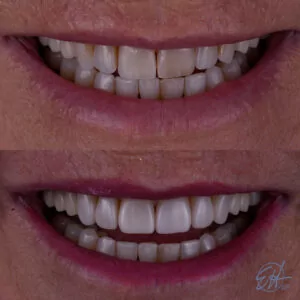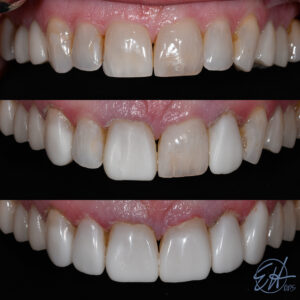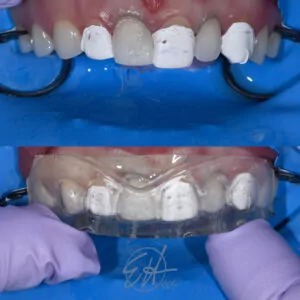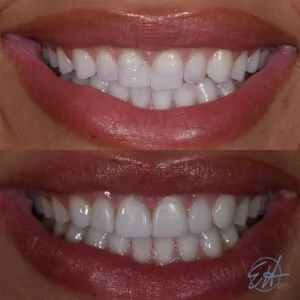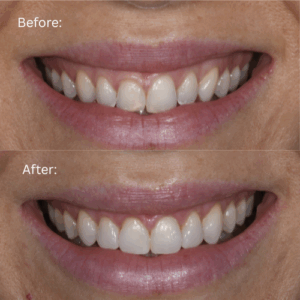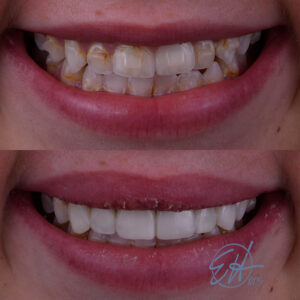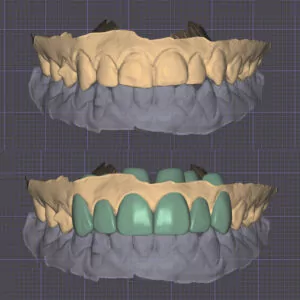Improve Your Smile Without Major Work
Sometimes, small changes can make a big impact. If you’re looking to smooth out a chipped tooth, even out the edges of your smile, or cover stains that whitening hasn’t touched, composite veneers may be the best solution. Without doing anything too invasive, composite veneers, also called resin veneers, can be placed with injection molding.
This technique uses a clear, custom-made guide that’s created from a digital scan of your teeth. It allows us to place tooth-colored resin with a high level of precision. Instead of building and shaping everything by hand, we inject the material into the guide, then refine it once it’s set. The final result is smooth, natural-looking, and often completed in just one visit.
Injection Molding Process
We begin with a digital scan of your teeth. From that scan, we design a 3D model of your ideal smile and use it to create a clear template that fits over your teeth. That template shows us exactly where to apply the material so everything ends up balanced and symmetrical.
Once the surface of the teeth are cleaned—usually with no tooth removal needed—we place the guide and inject the composite resin into it. After it sets, we remove the guide, shape each tooth, and polish everything until it blends in seamlessly.
Patient Case: Shelly
What Makes This Option So Appealing
Injection molding offers a more conservative alternative to traditional veneers or cosmetic bonding. It’s ideal for people who want to improve their smile without committing to more extensive dental work. Some of the key benefits include:
- Little to no drilling
- Each veneer is digitally designed and shaped ahead of time
- Often completed in a single visit
- More affordable than porcelain
- Natural-looking, balanced results
It’s a great option if your teeth have a bit of wear, some cosmetic flaws you’d like to fix, or older bonding that’s starting to show its age. The resin we use for these veneers blends in beautifully with natural enamel, especially when it’s planned and applied using this technique.
Patient Case: Jane
A Look at Real Results
We’ve used this technique to help people improve their smiles in all kinds of subtle, effective ways. It can be a great solution for someone who’s worn down their teeth over time or who just wants their smile to look more even, bright, or balanced.
Some cases may also involve light gum contouring (as with Amanda’s treatment), which can help refine the overall shape of the smile. Combining techniques like this allows us to get the best results based on your unique features.
Patient Cases: Amanda & Anastasia
Could This Be the Right Fit for You?
Resin veneers are a great option if you’re looking for a cosmetic upgrade without invasive treatment. Injection molded veneers tend to work best when your teeth are mostly in good shape but need a little refining. Maybe there’s a chip that’s been bothering you, or your edges have worn down a bit over time. It’s also a great option for smoothing out uneven spots or covering stains that don’t respond well to whitening.
If you’ve got older fillings or more significant wear, we may look at other solutions, like crowns or restorative treatments, but that’s something we’ll talk through together. The goal is to find the option that fits your smile and what you’re hoping to improve.
Patient Case: Alexis
Frequently Asked Questions
What’s the difference between composite veneers and resin veneers?
They’re actually the same thing. Composite is the type of material used, and resin is what it’s made of. Some people refer to them as “resin veneers,” while others say “composite veneers,” but they both describe thin, tooth-colored layers bonded to the front of your teeth to improve appearance.
How long do resin veneers last?
With good care, and correct tooth alignment, composite veneers can last for many years. They’re durable, but not quite as long-lasting as porcelain. The upside is they’re easier to repair or touch up over time if needed.
Are resin veneers safe for my teeth?
Yes. One of the best things about this technique is how gentle it is on your natural teeth. In many cases, we don’t need to remove any enamel at all. The material bonds right to the surface, making this a very conservative cosmetic treatment.
Can I whiten resin veneers?
Whitening treatments don’t work on composite material the same way they do on natural enamel. If your veneers start to look dull or stained over time, they can be polished or refreshed in-office, but we recommend whitening your natural teeth before treatment, so everything matches nicely.
What if one veneer chips or stains—can it be fixed?
Yes! That’s one of the advantages of composite over porcelain. If a resin veneer gets damaged, it can often be repaired or reshaped without needing to replace the entire thing. We can typically fix minor chips in a single visit.
Is this a good option if I grind my teeth?
If you grind your teeth, we’ll want to talk about that before placing veneers. In some cases, we may recommend a night guard to protect your smile. Composite can still be used safely, but we’ll tailor the treatment plan based on your bite and habits.
Does insurance cover composite veneers?
Most dental insurance plans don’t cover veneers if they’re done for cosmetic reasons. That said, if there’s damage involved, like a chip or wear that’s affecting your bite or health, it’s worth checking. We’re happy to look into your plan and let you know what’s possible.
Ready to Explore Your Options?
Thinking about making a change? This is a simple, low-stress place to start. Injection molding gives you a way to refresh your smile without a big commitment or invasive procedure.
Call us at 616-784-2377, or reach out online to set up a time to come in. We’ll take a look, answer your questions, and help you figure out what makes the most sense for your smile and your goals.


